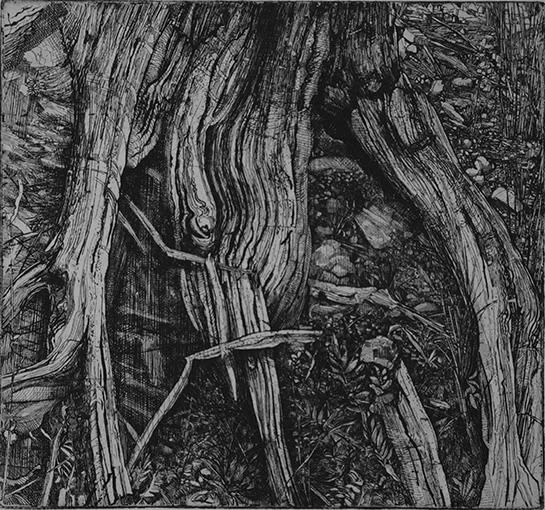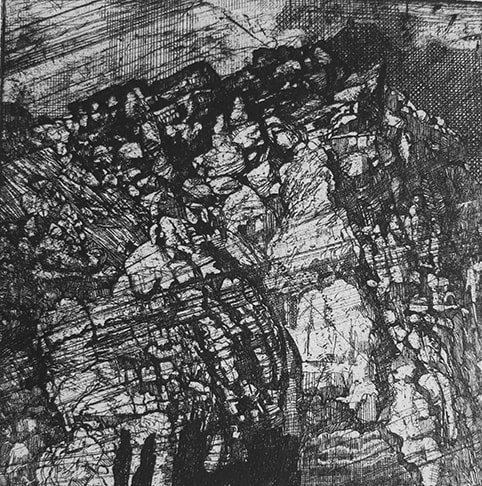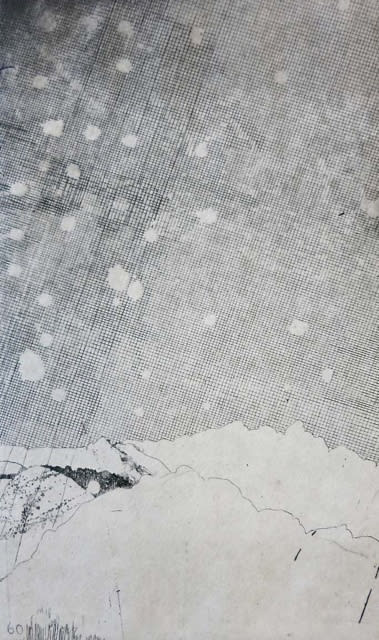Raymond Arnold: Elsewhere World
Where can it be found again,
An elsewhere world, beyond
Maps and atlases,
Where all is woven into
And of itself, like a nest
Of crosshatched grass blades?
Seamus Heaney, Human Chain 2010
An English painter friend sent me a book of Seamus Heaney’s poetry in 2011. The gift coincided with my commencement of work on a new etching series. I was developing prints of some terrain on Mt Lyell which is still heavily scarred from historic mining impacts and deforestation. Plants are re-colonising the area, however, with the White Waratah, Christmas bells, Celery top pine, Sassafras and even King Billy pine in evidence. It is in this sense of the possibility of another (elsewhere) world, i.e. one that is lost but one that might be reclaimed that I’m interesting in speculating on in the new work.
I live in Queenstown, Tasmania, where I established LARQ or Landscape Art Research Queenstown nearly a decade ago. LARQ is a small art centre involving both gallery and print studio which was set up to encourage artists to visit Western Tasmania and contribute to its environmental repair and community development. It closes this year.
The terrain of Western Tasmania has been tempered and shaped by exposure to forces of nature and man. A prevailing westerly air-stream with two and a half metres of rain per year and a hundred years of mining have sculpted the hard rock landscape. Author Chris Binks describes it so in response to a gift of a small etching of mine:
I always think of Lyell as a tough, defiant little mountain. It is overlooked by its higher neighbours, deeply scarred by the open cuts and denuded by fires, but its crags stand proudly. You have captured its intricate rock architecture and its harsh beauty.
Large tracts of wet rainforest nearby give way to more settled and pastoral areas to the east of me and eventually the MONA-centric Hobart. This dynamic natural environment has shaped Tasmanian identity and culture. The toxic mine sites, degraded landscapes, and abandoned cemeteries are testimony to these natural forces, the passage of time and the transience of life. My prints in this exhibition reflect this construction of a landscape and the identification with ‘ground’.
For many years I researched the intaglio print medium in Europe. I originally went to Paris and the Atelier Lacourière et Frélaut, in particular, to connect to the tradition of making etchings. My great-grandfather’s experiences of the First World War as a soldier in the AIF, Commonwealth War Grave sites and body armour are concepts that have been played out in tandem with my investigation into the print and identification with a type of ‘figure’ as much as ground!
In the early 1980s I developed several large prints about the landscape of Western Tasmania. They were ’postcards’ for imaginary audiences far over the horizon – images of wild, desolate, indifferent places just beginning to feel the pressure of the approaching bulldozer. Imaginary Landscape - Eighteen months in Tasmania (1984) and Florentine Valley: displaced landscape (1984) were big panoramic images intended for audiences in big city galleries. That is where they rest now – in National and State Gallery collections, in plan drawers and in dark quiet archives beyond the gaze.
The pictures in this Bett Gallery, Hobart exhibition which is titled Elsewhere World ‘bookend’ that earlier work. They share some characteristics with those artworks from 30 years ago but essentially they represent a big change. That shift in meaning and context is bound up with the fact that I live and will hopefully die within the pictured landscape and that the audience for these paintings surrounds me in the ‘here and now’. It is me! It is you!
-
 Raymond ArnoldElsewhere World - 10th State, 2015etching panorama, unframed80 x 330cmAU$ 5,500.00
Raymond ArnoldElsewhere World - 10th State, 2015etching panorama, unframed80 x 330cmAU$ 5,500.00 -
 Raymond ArnoldElsewhere World - First digital proof, 2015digital print145 x 106cmAU$ 1,050.00
Raymond ArnoldElsewhere World - First digital proof, 2015digital print145 x 106cmAU$ 1,050.00 -
 Raymond ArnoldElsewhere World - Transitional Image V, 2015digital print on Arches 300gsm paper120 x 100cmAU$ 1,050.00
Raymond ArnoldElsewhere World - Transitional Image V, 2015digital print on Arches 300gsm paper120 x 100cmAU$ 1,050.00 -
 Raymond ArnoldElsewhere World - Transitional Image III, 2015digital print on Arches 300gsm100 x 90cmAU$ 950.00
Raymond ArnoldElsewhere World - Transitional Image III, 2015digital print on Arches 300gsm100 x 90cmAU$ 950.00 -
 Raymond ArnoldElsewhere World - Transitional Image IV, 2015digital print on Arches 300gsm paper100 x 90cmAU$ 950.00
Raymond ArnoldElsewhere World - Transitional Image IV, 2015digital print on Arches 300gsm paper100 x 90cmAU$ 950.00 -
 Raymond ArnoldElsewhere world fragment No.1, 2015etching on 300gsm Velin Arches40 x 30cmAU$ 350.00
Raymond ArnoldElsewhere world fragment No.1, 2015etching on 300gsm Velin Arches40 x 30cmAU$ 350.00 -
 Raymond ArnoldElsewhere world fragment No.2, 2015etching on 300gsm Velin Arches, unframed40 x 30cm paper sizeAU$ 350.00
Raymond ArnoldElsewhere world fragment No.2, 2015etching on 300gsm Velin Arches, unframed40 x 30cm paper sizeAU$ 350.00 -
 Raymond ArnoldElsewhere world fragment No.3, 2015etching on 300gsm Velin Arches, unframed40 x 30cm paper sizeAU$ 350.00
Raymond ArnoldElsewhere world fragment No.3, 2015etching on 300gsm Velin Arches, unframed40 x 30cm paper sizeAU$ 350.00 -
 Raymond ArnoldElsewhere world fragment No.4, 2015etching on 300gsm Velin Arches, unframed40 x 30cm, paper sizeAU$ 350.00
Raymond ArnoldElsewhere world fragment No.4, 2015etching on 300gsm Velin Arches, unframed40 x 30cm, paper sizeAU$ 350.00 -
 Raymond ArnoldElsewhere world fragments No.5, 2015etching on 300gsm Velin Arches40 x 30cmAU$ 350.00
Raymond ArnoldElsewhere world fragments No.5, 2015etching on 300gsm Velin Arches40 x 30cmAU$ 350.00 -
 Raymond ArnoldElsewhere world fragments No.6, 2015etching on 300gsm Velin Arches40 x 30cmAU$ 350.00
Raymond ArnoldElsewhere world fragments No.6, 2015etching on 300gsm Velin Arches40 x 30cmAU$ 350.00 -
 Raymond ArnoldElsewhere world fragments No.7, 2015etching on 300gsm Velin Arches40 x 30cmAU$ 350.00
Raymond ArnoldElsewhere world fragments No.7, 2015etching on 300gsm Velin Arches40 x 30cmAU$ 350.00 -
 Raymond ArnoldElsewhere world fragments No.8, 2015etching on 300gsm Velin Arches40 x 30cmAU$ 350.00
Raymond ArnoldElsewhere world fragments No.8, 2015etching on 300gsm Velin Arches40 x 30cmAU$ 350.00 -
 Raymond ArnoldElsewhere world fragments No.9, 2015etching on 300gsm Velin Arches40 x 30cmAU$ 350.00
Raymond ArnoldElsewhere world fragments No.9, 2015etching on 300gsm Velin Arches40 x 30cmAU$ 350.00 -
 Raymond ArnoldElsewhere world fragment No.10, 2015etching on 300gsm Velin Arches, unframed40 x 30cm, paper sizeAU$ 350.00
Raymond ArnoldElsewhere world fragment No.10, 2015etching on 300gsm Velin Arches, unframed40 x 30cm, paper sizeAU$ 350.00 -
 Raymond ArnoldElsewhere world fragment No.11, 2015etching on 300gsm Velin Arches, unframed40 x 30cm, paper sizeAU$ 350.00
Raymond ArnoldElsewhere world fragment No.11, 2015etching on 300gsm Velin Arches, unframed40 x 30cm, paper sizeAU$ 350.00 -
 Raymond ArnoldElsewhere world fragment No.12, 2015etching on 300gsm Velin Arches, unframed40 x 30cm, paper sizeAU$ 350.00
Raymond ArnoldElsewhere world fragment No.12, 2015etching on 300gsm Velin Arches, unframed40 x 30cm, paper sizeAU$ 350.00 -
 Raymond ArnoldElsewhere world fragment No.13, 2015etching on 300gsm Velin Arches, unframed40 x 30cm, paper sizeAU$ 350.00
Raymond ArnoldElsewhere world fragment No.13, 2015etching on 300gsm Velin Arches, unframed40 x 30cm, paper sizeAU$ 350.00 -
 Raymond ArnoldElsewhere world fragment No.14, 2015etching on 300gsm Velin Arches, unframed40 x 30cm, paper sizeAU$ 350.00
Raymond ArnoldElsewhere world fragment No.14, 2015etching on 300gsm Velin Arches, unframed40 x 30cm, paper sizeAU$ 350.00 -
 Raymond ArnoldElsewhere world fragment No.15, 2015etching on 300gsm Velin Arches, unframed40 x 30cm, paper sizeAU$ 350.00
Raymond ArnoldElsewhere world fragment No.15, 2015etching on 300gsm Velin Arches, unframed40 x 30cm, paper sizeAU$ 350.00 -
 Raymond ArnoldElsewhere world fragment No.16, 2015etching on 300gsm Velin Arches, unframed40 x 30cm, paper sizeAU$ 350.00
Raymond ArnoldElsewhere world fragment No.16, 2015etching on 300gsm Velin Arches, unframed40 x 30cm, paper sizeAU$ 350.00 -
 Raymond ArnoldElsewhere world fragment No.17, 2015etching on 300gsm Velin Arches, unframed40 x 30cm, paper sizeAU$ 350.00
Raymond ArnoldElsewhere world fragment No.17, 2015etching on 300gsm Velin Arches, unframed40 x 30cm, paper sizeAU$ 350.00 -
 Raymond ArnoldElsewhere world fragment No.18, 2015etching on 300gsm Velin Arches, unframed40 x 30cm, paper sizeAU$ 350.00
Raymond ArnoldElsewhere world fragment No.18, 2015etching on 300gsm Velin Arches, unframed40 x 30cm, paper sizeAU$ 350.00 -
 Raymond ArnoldElsewhere world fragment No.19, 2015etching on 300gsm Velin Arches, unframed40 x 30cm, paper sizeAU$ 350.00
Raymond ArnoldElsewhere world fragment No.19, 2015etching on 300gsm Velin Arches, unframed40 x 30cm, paper sizeAU$ 350.00 -
 Raymond ArnoldElsewhere world fragment No.20, 2015etching on 300gsm Velin Arches, unframed40 x 30cm, paper sizeAU$ 350.00
Raymond ArnoldElsewhere world fragment No.20, 2015etching on 300gsm Velin Arches, unframed40 x 30cm, paper sizeAU$ 350.00 -
 Raymond ArnoldElsewhere world fragment No.21, 2015etching on 300gsm Velin Arches, unframed40 x 30cm, paper sizeAU$ 350.00
Raymond ArnoldElsewhere world fragment No.21, 2015etching on 300gsm Velin Arches, unframed40 x 30cm, paper sizeAU$ 350.00 -
 Raymond ArnoldElsewhere world fragment No.22, 2015etching on 300gsm Velin Arches, unframed40 x 30cm, paper sizeAU$ 350.00
Raymond ArnoldElsewhere world fragment No.22, 2015etching on 300gsm Velin Arches, unframed40 x 30cm, paper sizeAU$ 350.00 -
 Raymond ArnoldElsewhere world fragment No.23, 2015etching on 300gsm Velin Arches, unframed40 x 30cm, paper sizeAU$ 350.00
Raymond ArnoldElsewhere world fragment No.23, 2015etching on 300gsm Velin Arches, unframed40 x 30cm, paper sizeAU$ 350.00 -
 Raymond ArnoldElsewhere world fragment No.24, 2015etching on 300gsm Velin Arches, unframed40 x 30cm, paper sizeAU$ 350.00
Raymond ArnoldElsewhere world fragment No.24, 2015etching on 300gsm Velin Arches, unframed40 x 30cm, paper sizeAU$ 350.00 -
 Raymond ArnoldElsewhere world fragment No.25, 2015etching on 300gsm Velin Arches, unframed40 x 30cm, paper sizeAU$ 350.00
Raymond ArnoldElsewhere world fragment No.25, 2015etching on 300gsm Velin Arches, unframed40 x 30cm, paper sizeAU$ 350.00 -
 Raymond ArnoldElsewhere world fragment No.26, 2015etching on 300gsm Velin Arches, unframed40 x 30cm, paper sizeAU$ 350.00
Raymond ArnoldElsewhere world fragment No.26, 2015etching on 300gsm Velin Arches, unframed40 x 30cm, paper sizeAU$ 350.00 -
 Raymond ArnoldElsewhere world fragment No.27, 2015etching on 300gsm Velin Arches, unframed40 x 30cm, paper sizeAU$ 350.00
Raymond ArnoldElsewhere world fragment No.27, 2015etching on 300gsm Velin Arches, unframed40 x 30cm, paper sizeAU$ 350.00 -
 Raymond ArnoldElsewhere world fragment No.28, 2015etching on 300gsm Velin Arches, unframed40 x 30cm, paper sizeAU$ 350.00
Raymond ArnoldElsewhere world fragment No.28, 2015etching on 300gsm Velin Arches, unframed40 x 30cm, paper sizeAU$ 350.00 -
 Raymond ArnoldElsewhere world fragment No.29, 2015etching on 300gsm Velin Arches, unframed40 x 30cm, paper sizeAU$ 350.00
Raymond ArnoldElsewhere world fragment No.29, 2015etching on 300gsm Velin Arches, unframed40 x 30cm, paper sizeAU$ 350.00 -
 Raymond ArnoldElsewhere world fragment No.30, 2015etching on 300gsm Velin Arches, unframed40 x 30cm, paper sizeAU$ 350.00
Raymond ArnoldElsewhere world fragment No.30, 2015etching on 300gsm Velin Arches, unframed40 x 30cm, paper sizeAU$ 350.00 -
 Raymond ArnoldElsewhere world fragment No.31, 2015etching on 300gsm Velin Arches, unframed40 x 30cm, paper sizeAU$ 350.00
Raymond ArnoldElsewhere world fragment No.31, 2015etching on 300gsm Velin Arches, unframed40 x 30cm, paper sizeAU$ 350.00 -
 Raymond ArnoldElsewhere world fragment No.32, 2015etching on 300gsm Velin Arches, unframed40 x 30cm, paper sizeAU$ 350.00
Raymond ArnoldElsewhere world fragment No.32, 2015etching on 300gsm Velin Arches, unframed40 x 30cm, paper sizeAU$ 350.00 -
 Raymond ArnoldElsewhere world fragment No.33, 2015etching on 300gsm Velin Arches, unframed40 x 30cm, paper sizeAU$ 350.00
Raymond ArnoldElsewhere world fragment No.33, 2015etching on 300gsm Velin Arches, unframed40 x 30cm, paper sizeAU$ 350.00 -
 Raymond ArnoldElsewhere world fragment No.34, 2015etching on 300gsm Velin Arches, unframed40 x 30cm, paper sizeAU$ 350.00
Raymond ArnoldElsewhere world fragment No.34, 2015etching on 300gsm Velin Arches, unframed40 x 30cm, paper sizeAU$ 350.00 -
 Raymond ArnoldElsewhere world fragment No.35, 2015etching on 300gsm Velin Arches, unframed40 x 30cm, paper sizeAU$ 350.00
Raymond ArnoldElsewhere world fragment No.35, 2015etching on 300gsm Velin Arches, unframed40 x 30cm, paper sizeAU$ 350.00 -
 Raymond ArnoldElsewhere world fragment No.36, 2015etching on 300gsm Velin Arches, unframed40 x 30cm, paper sizeAU$ 350.00
Raymond ArnoldElsewhere world fragment No.36, 2015etching on 300gsm Velin Arches, unframed40 x 30cm, paper sizeAU$ 350.00 -
 Raymond ArnoldElsewhere world fragment No.37, 2015etching on 300gsm Velin Arches, unframed40 x 30cm, paper sizeAU$ 350.00
Raymond ArnoldElsewhere world fragment No.37, 2015etching on 300gsm Velin Arches, unframed40 x 30cm, paper sizeAU$ 350.00 -
 Raymond ArnoldElsewhere world fragment No.38, 2015etching on 300gsm Velin Arches, unframed40 x 30cm, paper sizeAU$ 350.00
Raymond ArnoldElsewhere world fragment No.38, 2015etching on 300gsm Velin Arches, unframed40 x 30cm, paper sizeAU$ 350.00 -
 Raymond ArnoldElsewhere world fragment No.39, 2015etching on 300gsm Velin Arches, unframed40 x 30cm, paper sizeAU$ 350.00
Raymond ArnoldElsewhere world fragment No.39, 2015etching on 300gsm Velin Arches, unframed40 x 30cm, paper sizeAU$ 350.00 -
 Raymond ArnoldElsewhere world fragment No.40, 2015etching on 300gsm Velin Arches, unframed40 x 30cm, paper sizeAU$ 350.00
Raymond ArnoldElsewhere world fragment No.40, 2015etching on 300gsm Velin Arches, unframed40 x 30cm, paper sizeAU$ 350.00 -
 Raymond ArnoldElsewhere world fragment No.41, 2015etching on 300gsm Velin Arches, unframed40 x 30cm, paper sizeAU$ 350.00
Raymond ArnoldElsewhere world fragment No.41, 2015etching on 300gsm Velin Arches, unframed40 x 30cm, paper sizeAU$ 350.00 -
 Raymond ArnoldElsewhere world fragment No.42, 2015etching on 300gsm Velin Arches, unframed40 x 30cm, paper sizeAU$ 350.00
Raymond ArnoldElsewhere world fragment No.42, 2015etching on 300gsm Velin Arches, unframed40 x 30cm, paper sizeAU$ 350.00 -
 Raymond ArnoldElsewhere world fragment No.43, 2015etching on 300gsm Velin Arches, unframed40 x 30cm, paper sizeAU$ 350.00
Raymond ArnoldElsewhere world fragment No.43, 2015etching on 300gsm Velin Arches, unframed40 x 30cm, paper sizeAU$ 350.00 -
 Raymond ArnoldElsewhere world fragment No.44, 2015etching on 300gsm Velin Arches, unframed40 x 30cm, paper sizeSold
Raymond ArnoldElsewhere world fragment No.44, 2015etching on 300gsm Velin Arches, unframed40 x 30cm, paper sizeSold -
 Raymond ArnoldElsewhere world fragment No.45, 2015etching on 300gsm Velin Arches, unframed40 x 30cm, paper sizeAU$ 350.00
Raymond ArnoldElsewhere world fragment No.45, 2015etching on 300gsm Velin Arches, unframed40 x 30cm, paper sizeAU$ 350.00 -
 Raymond ArnoldElsewhere world fragment No.46, 2015etching on 300gsm Velin Arches, unframed40 x 30cm, paper sizeAU$ 350.00
Raymond ArnoldElsewhere world fragment No.46, 2015etching on 300gsm Velin Arches, unframed40 x 30cm, paper sizeAU$ 350.00 -
 Raymond ArnoldElsewhere world fragment No.47, 2015etching on 300gsm Velin Arches, unframed40 x 30cm, paper sizeAU$ 350.00
Raymond ArnoldElsewhere world fragment No.47, 2015etching on 300gsm Velin Arches, unframed40 x 30cm, paper sizeAU$ 350.00 -
 Raymond ArnoldElsewhere world fragment No.48, 2015etching on 300gsm Velin Arches, unframed40 x 30cm, paper sizeAU$ 350.00
Raymond ArnoldElsewhere world fragment No.48, 2015etching on 300gsm Velin Arches, unframed40 x 30cm, paper sizeAU$ 350.00 -
 Raymond ArnoldElsewhere world fragment No.49, 2015etching on 300gsm Velin Arches, unframed40 x 30cm, paper sizeAU$ 350.00
Raymond ArnoldElsewhere world fragment No.49, 2015etching on 300gsm Velin Arches, unframed40 x 30cm, paper sizeAU$ 350.00 -
 Raymond ArnoldElsewhere world fragment No.50, 2015etching on 300gsm Velin Arches, unframed40 x 30cm, paper sizeAU$ 350.00
Raymond ArnoldElsewhere world fragment No.50, 2015etching on 300gsm Velin Arches, unframed40 x 30cm, paper sizeAU$ 350.00 -
 Raymond ArnoldElsewhere world fragment No.51, 2015etching on 300gsm Velin Arches, unframed40 x 30cm, paper sizeAU$ 350.00
Raymond ArnoldElsewhere world fragment No.51, 2015etching on 300gsm Velin Arches, unframed40 x 30cm, paper sizeAU$ 350.00 -
 Raymond ArnoldElsewhere world fragments No.52, 2015etching on 300gsm Velin Arches40 x 30cmAU$ 350.00
Raymond ArnoldElsewhere world fragments No.52, 2015etching on 300gsm Velin Arches40 x 30cmAU$ 350.00 -
 Raymond ArnoldElsewhere world fragments No.53, 2015etching on 300gsm Velin Arches40 x 30cmAU$ 350.00
Raymond ArnoldElsewhere world fragments No.53, 2015etching on 300gsm Velin Arches40 x 30cmAU$ 350.00 -
 Raymond ArnoldElsewhere world fragments No.54, 2015etching on 300gsm Velin Arches40 x 30cmAU$ 350.00
Raymond ArnoldElsewhere world fragments No.54, 2015etching on 300gsm Velin Arches40 x 30cmAU$ 350.00 -
 Raymond ArnoldElsewhere world fragments No.55, 2015etching on 300gsm Velin Arches40 x 30cmAU$ 350.00
Raymond ArnoldElsewhere world fragments No.55, 2015etching on 300gsm Velin Arches40 x 30cmAU$ 350.00 -
 Raymond ArnoldElsewhere world fragments No.56, 2015etching on 300gsm Velin Arches40 x 30cmAU$ 350.00
Raymond ArnoldElsewhere world fragments No.56, 2015etching on 300gsm Velin Arches40 x 30cmAU$ 350.00 -
 Raymond ArnoldElsewhere world fragments No.57, 2015etching on 300gsm Velin Arches40 x 30cm, paper sizeAU$ 350.00
Raymond ArnoldElsewhere world fragments No.57, 2015etching on 300gsm Velin Arches40 x 30cm, paper sizeAU$ 350.00 -
 Raymond ArnoldElsewhere world fragments No.58, 2015etching on 300gsm Velin Arches40 x 30cmAU$ 350.00
Raymond ArnoldElsewhere world fragments No.58, 2015etching on 300gsm Velin Arches40 x 30cmAU$ 350.00 -
 Raymond ArnoldElsewhere world fragments No.59, 2015etching on 300gsm Velin Arches40 x 30cmAU$ 350.00
Raymond ArnoldElsewhere world fragments No.59, 2015etching on 300gsm Velin Arches40 x 30cmAU$ 350.00 -
 Raymond ArnoldElsewhere world fragments No.60, 2015etching on 300gsm Velin Arches40 x 30cmAU$ 350.00
Raymond ArnoldElsewhere world fragments No.60, 2015etching on 300gsm Velin Arches40 x 30cmAU$ 350.00


































































